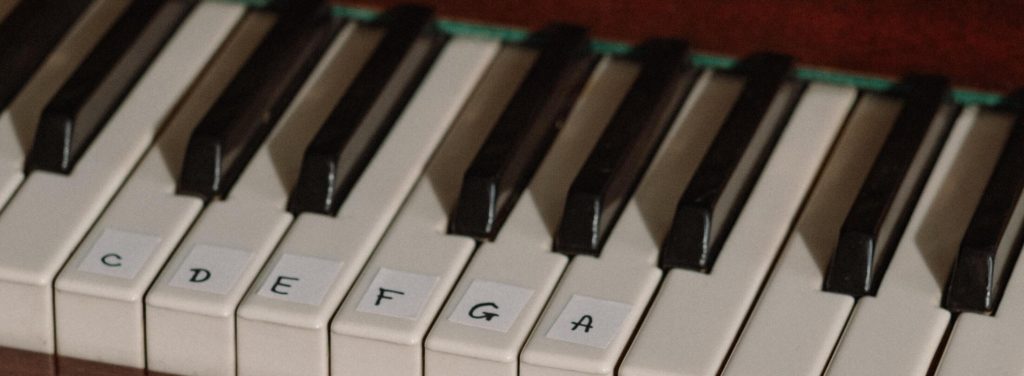Basic Music Theory every producer should know

Music theory can be confusing and many music producers find it difficult. It often gets a bad reputation due to the use of jargon and complex terminology. However, it is a skill that can be learned with dedication and used as a valuable tool for understanding how music works.
Music producers who have a basic understanding of music theory will essentially be more effective in their craft. They will have more tools to work with and be more disciplined in their approach. This applies to any genre, including HipHop, EDM, Latin music, etc. They won’t doubt their ability to come up with new material, as they view it as a skill they have been trained to deal with. Ultimately, this is the main benefit of learning music theory intricacies.
The Basics
For beginners, it’s essential to understand music theory for piano. Piano is the most crucial instrument to master as it is the foundation for every DAW’s (Digital Audio Workstation) midi and composition editing. This fundamental knowledge is not only limited to piano but is the most commonly used instrument to learn the basics of music theory.

White Keys
The white keys on your keyboard are the so called “natural” notes in a scale (C, D, E, F, G, A, B). Playing exclusively on the white keys will put you in either the key of C major or A minor, a great starting point for music beginners.
Black Keys
The black keys on the keyboard play the sharp and flat notes (C#, Eb, etc.). Incorporating these black keys with the white keys will open up the possibility of playing in various other keys beyond C major and A minor.
Intervals
An interval refers to the distance between one note and another. The smallest interval in western music is called a semitone, represented by the distance between adjacent notes on a keyboard (for example: E to F) . It’s also known as a half-step or minor second and is half the size of a whole tone or whole step (two semitones apart).
Most musical scales are built on a combination of whole and half steps, and chords can also be defined by using these intervals. It is crucial to learn about whole and half steps early on.
Scales (Major and Minor scales)
Musical scales are a set of notes that when combined, create a specific sound. While it’s possible to play a melody using all 12 notes in an octave, it doesn’t always sound pleasing. Scales limit the notes used to a specific combination, usually seven, across all instruments. When playing alone, scales may not be as important, but when multiple instruments are playing together, it is crucial for them to be in the same scale to create harmony and a pleasing sound. It’s not necessary to memorize hundreds of scales, but a basic understanding of a few can greatly enhance your music-making abilities.
Major Scales
Major scales are a specific set of seven notes that is made up of the following intervals: whole, whole, half, whole, whole, whole, half. This pattern is the same for any major scale, regardless of the starting note. The most common major scale is the C Major scale, which consists of the notes C, D, E, F, G, A, B, and C.
For example, the G Major scale would be G, A, B, C, D, E, F#, G, and the pattern of intervals is the same. Major scales have a characteristic of sounding “happy” and “bright”.
Minor Scales (Natural)
Minor scales are also a specific set of seven notes that is made up of the following intervals: whole, half, whole, whole, half, whole, whole. This pattern is considered as the natural minor scale. The most common minor scale is the A minor scale, which consists of the notes A, B, C, D, E, F, G, A.
This pattern is the same for any natural minor scale, regardless of the starting note. For example, the E minor scale would be E, F#, G, A, B, C, D, E, and the pattern of intervals is the same. The natural minor scale has a characteristic “sad” or “dark” sound.
Minor Scales (Harmonic)
There’s also another type of minor scales called harmonic minor scales which are a variation of natural minor scales with a different pattern of intervals. The harmonic minor scale pattern is made up of the following intervals: whole, half, whole, whole, half, augmented second, half (or whole and a half step). This pattern is the same for any harmonic minor scale, regardless of the starting note.
They are formed by raising the seventh note of the natural minor scale by a semitone (half step). This creates a different pattern of intervals and also a different sound. The most common harmonic minor scale is A harmonic minor, which consists of the notes A, B, C, D, E, F, G#, A. The harmonic minor scale has a characteristic “exotic” or “dramatic” sound. It’s often used in traditional music and in some genres like classical and flamenco.
Tonic Note
The tonic note, also known as the “root” or “keynote” of a scale, is the foundation and reference point for the rest of the notes in the scale. It’s the first and most important note of a scale. In major scales, it’s the note the scale is named after, such as C in C Major or G in G Major. In minor scales, it’s the note the scale is named after, like A in A minor or E in E minor. It gives the scale its tonality or sense of being in a specific key. The tonic note is often used as the final note of a melody or phrase to create a sense of resolution and stability.
Octave
An octave is the distance between two notes with the same name but different pitches. It’s the interval between one musical pitch and another with half or double its frequency. For example, the C note in the C major scale is an octave apart from the next C note in the higher register. The relationship of an octave is considered to be the most important interval in music. Octaves are used as a reference point when tuning instruments and also when composing, arranging and improvising music. In Western music, an octave is divided into 12 semitones or half-steps, each corresponding to a piano key.
Major Chords
A major chord is composed of three notes: the root note, a second note that is 4 semitones or 2 whole steps above the root, and a third note that is 7 semitones or 1 and a half step above the second note. An example of this can be seen in a C Major chord, which is made up of the notes C, E, and G.
Major chords have a “happy” and “bright” sound.
Minor Chords
A minor chord is made up of three notes: the root note, a second note that is 3 semitones or one and a half steps above the root, and a third note that is 7 semitones or two whole steps above the second note. An example of this can be seen in a D Minor chord, which is composed of the notes D, F, and A.
Minor chords have a “sad” or “dark” sound.
There’s also another type of minor chords called harmonic minor chords which are built on the first, third and fifth scale degrees of the harmonic minor scale. These chords have a more “exotic” or “dramatic” sound.
Roman Numeral Analysis
Roman numeral analysis uses Roman numerals to identify chords within a given key. The Roman numeral indicates the chord’s root note, relative to the key’s tonic note. A capital Roman numeral represents a major chord, while a lowercase Roman numeral represents a minor chord.
For example, in the key of C major, the Roman numeral V represents the chord of G Major (because G is the fifth note in the C major scale and the Roman numeral is capitalized indicating a major chord)
In the key of A minor, the Roman numeral iv represents the chord of D Minor (because D is the fourth note in the A minor scale and the Roman numeral is lowercase indicating a minor chord)
Inversion
An inversion is a variation of a chord where the notes are transposed to different octaves. A chord can be inverted by moving one or more notes to a different octave. For example, C major chord (C-E-G) can be inverted by moving the lowest note E to a higher octave, resulting in the chord E-G-C. This changes the overall sound and the harmonic structure of the chord.
7th & 9th Chords
The inclusion of the 7ths and 9ths in chords refers to the addition of the seventh or ninth note, respectively, above the root note of the chord. For example, Cmaj7 refers to a C Major chord with the addition of the seventh note above the root, B. This chord would be written as C-E-G-B. Similarly, a Cmaj9 chord would include the ninth note above the root, D, and the chord would be written as C-E-G-B-D. These extensions can add a more complex and rich sound to the chord, and can also be combined with other extensions such as the 11th or 13th to create even more complex chords.
Chord Progressions
Chord progressions often serve as the foundation for many melodic compositions. Even if you begin the composition process with something other than a chord progression, it is likely that you will eventually want to align your melody or hook with a chord progression. While there may be certain musical styles that do not heavily rely on chord progressions, they are generally considered to be the norm.
One interesting aspect to note is that chord progressions cannot be copyrighted, which means you are free to use existing songs as inspiration for your own compositions or to help spark your creativity when writing. With this in mind, it is important to familiarize yourself with the basics of using chord progressions in your music.
Ultimately, it is important to understand that chord progressions in Western music are typically straightforward and don’t require constant reinvention. Especially for beginners, it is not necessary to constantly come up with new chord progressions.
In summary, chord progressions in Western music are relatively simple and you don’t need to come up with something new every time you create one. Especially for beginners, it’s not necessary to always strive for originality in chord progressions.
Using Roman numeral analysis in chord progressions, you can try experimenting with the following popular chord progressions:
- I V vi IV, which is used in songs like “Use Somebody” by Kings of Leon or “All About That Bass” by Meghan Trainor
(Most commonly used in every genre, very versitile) - V IV I, which is used in songs like “Wonderwall” by Oasis or “The Way You Make Me Feel” by Michael Jackson
(Most commonly used in rock, pop and country music) - I vi IV V, which is used in songs like “Baby” by Justin Bieber or “Numb” by Linkin Park
(Most commonly used in pop and rock music) - ii IV V, which is used in songs like “”Summer of ’69” by Bryan Adams or “Satisfaction” by The Rolling Stones
(Most commonly used in blues and rock music) - vi I V ii, which is used in songs like “Wonderwall” and “Wake me Up When September Ends”.
(Not commonly used, mostly found in rock, pop and country music)
Remember that there are many other chord progressions out there, but starting with these will help you familiarize your ears and experiment with them.
Transposition
Transposition refers to the process of changing the pitch of a melody, chord progression, or entire piece of music by a certain interval. Transposing a piece of music involves shifting all the notes of the piece by the same interval, for example, raising or lowering them by a specific number of semitones (half-steps) or whole steps. This can change the key of the music, as well as its overall sound. Transposing is used for a variety of reasons, such as making a song easier to sing or play, to fit the range of a particular instrument or singer, or to create a different mood or style. Transposing can be done by ear or by using a transposition tool.
Additional Vocabulary
Chromatic Scale
A chromatic scale is a scale that uses all 12 notes in an octave, including the half-steps or semitones. It can be played in any order and is often used in improvisation or playing outside of a specific key. An example of this is playing all the white and black keys on a piano in ascending or descending order.
Diatonic
Diatonic refers to a musical scale or system that includes only the seven notes within a specific key or mode, it is a subset of the twelve notes of an octave and exclude the semitones or half-steps. Examples of diatonic scales are major and minor scales. The diatonic chords and melodies are those that can be played and composed using the notes of the diatonic scale.
Root Note
The root note, also known as the tonic note, is the first and most important note of a chord or scale, it serves as the foundation and reference point for the rest of the notes. It is the note on which the chord or scale is named and gives it its tonality.
Triad
A triad is a chord made up of three notes: the root, third and fifth of a scale, which creates the basic harmonic structure of the chord. Triads are the foundation for most chords used in Western music.
Circle of Fifths
The circle of fifths is a way to arrange musical keys in a circle, based on the relationships between their key signatures. It can be used to create chord progression using the pattern of moving up or down by fifths. It’s often used as a tool for composing, improvising, and understanding music theory
An example would be five chords built on F – C – G – D – A in that order.
Modes
A mode is a variation of a musical scale, created by starting on a different note other than the root. For example, playing the major scale from the second note, third note or fourth note, resulting in a different sound and feeling. These variations are known as modes, and each one is considered a different scale.
Dominant Chord
A dominant chord is a chord that is related to the interval of the fifth in a musical scale. In the key of D major, for example, the chord of A major is considered the dominant chord, as A is the fifth note in the scale of D.
Pitch
Pitch is the perceived highness or lowness of a sound. An example would be a high-pitched whistle compared to a low-pitched growl.
Rhythm
Rhythm refers to the timing and pace of a piece of music. It is the pattern of sounds and silences in time. For example, a steady beat with a consistent tempo is an example of rhythm in music.
Harmony
Harmony refers to the combination of two or more notes played at the same time to create chords. Harmony creates a sense of vertical dimension in music by adding depth and complexity to melodies. For example, in the chord C major, the notes C, E, and G are played together to create harmony.

